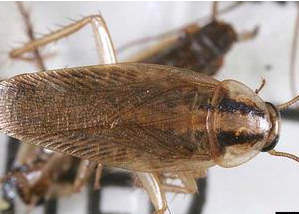German Cockroach
Blatella germanica
Identification
- light brown with two dark strips right behind the head
- small: 1/2 - 5/8 inch long
Nesting Habits
- prefer warm, moist areas near food preparation and/or storage (primary kitchen-infesting roach in Utah)
- found near sinks, appliances, furnaces, etc.
Diet
- highly varied and diverse
Significance
- may carry disease
- can cause allergic reactions or asthma symptoms
IPM Recommendations
- Educate occupants of building or room(s) of their role in eliminating roaches.
- Inspect incoming shipments of food or products for roaches or egg sacs.
- Improve sanitation (deep clean infested areas).
- Inspect and monitor all areas where food is prepared, stored, or eaten, and where moisture and heat are present.
- Use cockroach traps to determine infestation level, harborage location, movement and control success.
- Store food in pest-proof containers.
- Vacuum (with a HEPA filter) existing roaches and egg cases.
- Use roach baits and/or boric acid dust.
- Dispose of trash regularly to remove food and shelter sources.
- Do not store items in cardboard boxes long-term.
- Repair leaks and plumbing malfunctions.




